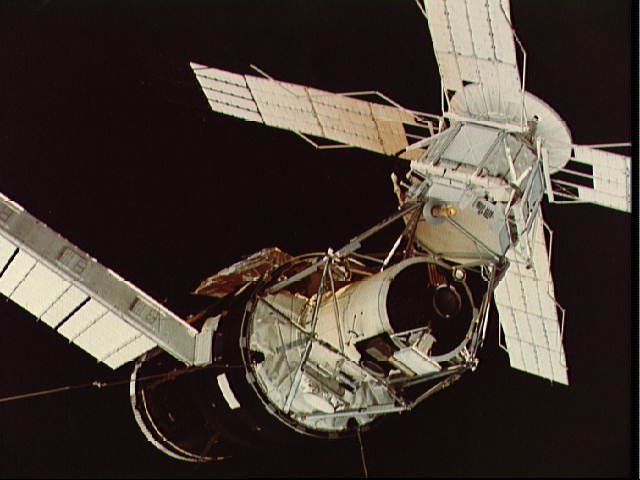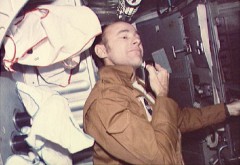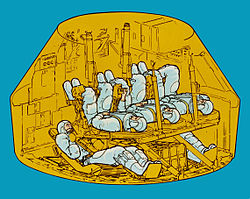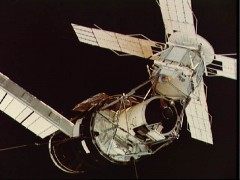
Forty years ago this summer, America’s first space station—Skylab—was boosted into orbit atop the last in a generation of mighty Saturn V rockets. During launch, however, disaster struck the mission, when the station’s micrometeoroid shield and one of its electricity-generating solar arrays were torn away in the aerodynamic slipstream and the first crew were faced with enormous difficulty to turning Skylab from a barely habitable hulk into their home for a month. They returned to Earth in late June 1973, leaving a vastly improved station for the next crew. On the second mission, Skylab 3, astronauts Al Bean, Owen Garriott, and Jack Lousma were tasked to spend a record-setting 59 days in orbit, more than twice as long as had been accomplished by any previous astronaut or cosmonaut. Launched on 28 July, the mission would prove an enormous success … but that success could hardly have been imagined during Skylab 3’s first few unfortunate days.
The astronauts’ first week in orbit was particularly unpleasant, as all three men suffered the effects of debilitating “space sickness,” as described in last week’s history article. By the beginning of August, they had begun to hit their stride. Then, with unexpected abruptness, something happened which threatened to terminate their mission before it had really begun. Early on the morning of 2 August, Garriott was secured into a rotating chair aboard the station, checking his body mass, when Lousma called him over to a window. Neither man could believe his eyes: for there was a snowstorm, in full fury, outside!
Garriott assumed that it was an auroral display, for he knew that they were flying over New Zealand and the southern auroral region at the time. However, he was left open-mouthed as a flurry of snowflake-like particles—“a real blizzard,” he recalled—flooded past the window. “Since it doesn’t snow very much in space,” Garriott deadpanned to the NASA oral historian, “we realised there had to be another explanation and in this case it was obvious.” It was a fuel leak from one of their Apollo spacecraft’s quads of Reaction Control System (RCS) thrusters. Bean and Lousma quickly identified a problem with the Quad D set of thrusters, one of four quads spaced around the service module. Another set (Quad B) had already failed a few days earlier and had been shut down.

At first, a link was not made with the Quad B problem. Temperatures in Quad D were falling rapidly and the crew were first advised to activate its backup heaters. An hour later, a further drop in temperature and pressure was noticed, suggesting that a second leak, similar to the Quad B incident, had indeed occurred—a suspicion confirmed by visual observations from the crew.
“We could see [the quantity] going down on the meter,” Lousma recalled, “so we shut off all the valves and made sure everything was secure, just closed up all the plumbing and reported it to Mission Control.”
With two of the four RCS quads shut down, the situation turned ugly, for the quads were a critical component of their maneuvering capability and the astronauts were only six days into a planned eight-week mission! The rate of the oxidiser leakage was low—only 10 percent had been lost—but Mission Control and the crew were concerned, since there was no indication of how rapidly it would increase. They could use two, or even one, quads to get home, but it was not acceptable for re-entry without further investigation.
Of paramount importance was figuring out why the failure had occurred. Was it a systemic flaw? Would there be a continuous stream of failures? Or was it a random pair of unrelated incidents which gave the appearance of having a common cause? No one knew. Early supposition was that the batch of nitrogen tetroxide might have been contaminated, which placed a cloud of uncertainty over the other two thruster sets, Quads A and C. Moreover, if the leaks persisted, internal circuits aboard the service module might render the craft unusable. Later that morning, Bean spoke directly to Chris Kraft, director of the Johnson Space Center in Houston, Texas, imploring him to allow them to remain aboard Skylab to complete their mission, but he was advised that if the situation worsened a rescue mission with a modified command and service module might be attempted. “If we had another leak,” Lousma reflected, “we sure wouldn’t have enough to get home.”

Acutely disappointed, the crew was now faced with the very real possibility of not only a curtailed mission … but maybe even the need for another crew to be hurriedly primed for launch to dock at Skylab’s second port and bring them home, abandoning their own craft. Rescue missions for Skylab had been extensively explored and planned for more than two years; indeed, rookie astronauts Vance Brand and Don Lind had undergone specific training to accomplish it. Both were experienced pilots and both were convinced that they could rescue Bean’s crew, if necessary. However, in August 1973 the dangers were evident: such a rescue mission had never been attempted, and if the thruster quad fault was a systemic flaw, it was possible that the rescue craft might be similarly affected. It would be a risky gamble … but one they were ready to take.
On 13 August, Time magazine reported the unsettling news from Skylab: that one of the service module’s four RCS thruster quads had sprung a leak shortly after launch and another quad had proven inoperable a few days later. Not only was Mission Control concerned that all four quads were of identical design, but their oxidiser—and the oxidiser for the big Service Propulsion System (SPS) engine—originated from the same batch. If that batch was contaminated, NASA could have a “generic” problem on its hands which might affect the whole spacecraft and prevent Bean, Garriott, and Lousma from returning home safely. In theory, Apollo could be controlled with just one quad or even using the thrusters on the command module itself, but the risk of further deterioration prompted the space agency to take steps to implement a rescue plan.

Skylab’s multiple docking adapter carried two ports, which permitted such a rescue mission to visit. Yet the effort itself was audacious and called for a second Apollo to be outfitted with five seats: two for Brand and Lind and three others for Bean, Garriott, and Lousma. The stranded crew could then transfer from the station to the rescue vehicle and return to Earth. Assessments of the practicability of this plan were made in April 1971, and it was considered possible for NASA to launch the mission at any time between ten and 45 days after being given the go-ahead. It was by no means a simple “paper” exercise: by March 1972, NASA had committed itself to having a Skylab rescue capability, and Navy and Air Force search and rescue helicopters supported trials at sea later that same year.
As the pilots on the crew, Bean and Lousma had devoted extensive training time to the rescue scenario. “Al and I worked with Rockwell and the NASA engineers,” Lousma told the NASA oral historian, “in configuring a command module that had two flat couches underneath the three couches on top and that would handle five people. In the centre, between the two people on the very bottom floor—on the ‘bottom bunk,’ so to speak—there was enough room to put some of the experimental data and other kinds of things you’d want to bring back for data reduction.” The biggest concern was the potential “stroking” of the upper deck of couches. Normally, the standard three couches were designed to “stroke,” or have their supports compress like a shock absorber, in the event of a rough landing. If that happened to the returning rescue craft, the supports might compress … onto the astronaut in the couch below! However, since no couch had ever stroked during any of the previous dozen Apollo splashdowns, NASA considered the risk a minimal one.
Now, in the first half of August 1973, it seemed that a rescue mission might really happen.
The final part of this article will appear tomorrow.
Want to keep up-to-date with all things space? Be sure to “Like” AmericaSpace on Facebook and follow us on Twitter:@AmericaSpace



